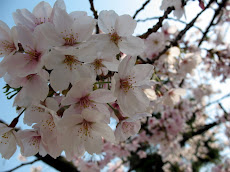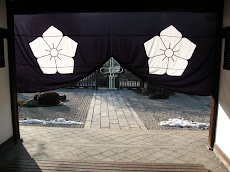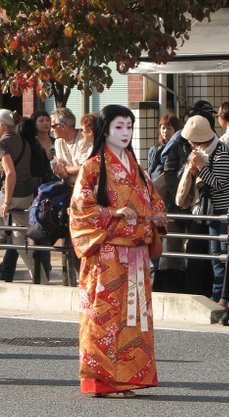First of all, my apologies for the inexcusable lack of posts for the last couple of weeks or so. It's impossible to write anything worthwhile if the creative juices just aren't flowing, and often it takes the right combination of factors to loosen the tap. I could merely offer up a brief accounting of our adventures here, but that would be a bland exercise in banality, and you deserve more than that. You deserve careful, measured commentary, and I intend to provide it for you. So here goes:
By now, I'm sure you've realized that life in Japan isn't just Hokkaido cream and peach blossoms; it's full of cultural walls to scale and linguistic obstacles to overcome. No seemingly simple, daily task is without its own devilish twist; going to the doctor for a checkup might as well be going to the moon. Nevertheless, there are moments that are so "Japanese" that I can't help but love my new home.
Case in point: two local businesses, each about two doors down from our house. One is a public bathhouse, and the other is a hole-in-the-wall sushi bar. I'll describe each in some detail.
Way back when, it used to be the case in Japan that every community had its own sento, or public bathhouse (this was before the days of private homes having their own tubs). The way it worked was like this: typically before or after your evening meal, you'd throw some soap and a towel into a little basket and you'd trot on down to the bath, where you'd get naked, take a long shower - in full view of the other bathers - and then soak in the hot, communal bath. "Skinship", as it is often called in English, was and continues to be an important aspect of Japanese society. At the baths, one can find both CEOs and street sweepers enjoying a hot soak, having divested themselves of the trappings of their respective stations.
I had previously been to an onsen, so when we finally decided to start frequenting the local sento, I was prepared. An onsen is like a sento, except an onsen uses mineral water pumped in from hot springs located all over Japan. Japan is an island rife with geothermic activity, and volcanoes, earthquakes, and hot springs all seem to go hand in hand. You take the good with the bad, I suppose. Depending on where you are, the hot spring water is said to have various healthful and restorative properties. The water from one town might help relieve arthritis, whereas the water from the town over might help cure migraines. You can never tell. As you can imagine, onsen are fantastically popular both with the locals and the tourists, both coming from far and wide to experience a few minutes in the tub. The sento, on the other hand, just heats up regular old tap water for its baths. In any event, the older lady who runs the sento next to our house had treated us very kindly in the past and had repeatedly asked us to visit her establishment, so we were more than happy to do so. That, and the fact that it's been getting pretty cold around here at night made taking a hot bath seem like a very agreeable way to spend the evening.
The entrance to the building is open, as are many storefronts in Japan, with only a half curtain hanging in the doorway. The sign outside displays the large, red, hiragana character ゆ, "yu". Yuu is the word for hot water. It has a corresponding kanji (Chinese character), but I've read that the kanji is used to represent hot water used for tea, whereas the hiragana is used to represent hot water used for people. Upon entering, you see that there are rows of foot lockers on either side, and that each side is divided by sex. You take off your shoes and hold them in your hand as you step up onto the actual floor (many establishments, including our own house, have an area exclusively for taking off ones shoes). You place your shoes in an empty locker and carry the wooden key with you as you enter the bath area - men entering through the doorway marked 男, and women through the doorway marked 女. Upon entering, the first thing you see are naked people walking around. As veterans of the stage, Katie and I are no strangers to seeing people in various states of undress (quick costume changes backstage quickly rob you of any sense of modesty), so seeing all this wasn't such a big deal, but I can easily imagine how the more repressed among us might have reacted to such a sight. Although really, anyone who goes to the gym and uses the locker rooms there with any regularity should already be quite desensitized. You pay several hundred yen (a few bucks) to the person supervising the bathhouse, and she gives you a little bottle of shampoo, soap, and a small towel. Most people prefer to bring their own supplies, though. You undress and throw your clothes into a small locker, taking only the towel (which is for washing - hopefully you remembered to bring something to dry yourself off with), shampoo, and soap with you, and proceed to yet another room which contains the actual bath.
In spite of their reputation for being polite and demure, there are a few sure-fire ways to piss Japanese people off, and one of the surest is failing to wash yourself properly before entering the bath. All along the walls are shower heads expressly for this purpose. You simply pull up a little plastic stool, have a seat (the shower heads are at waist level so you actually have to shower sitting down), and get to work with the shampoo and soap. Once you've scrubbed yourself completely, you take a well-earned seat in the bath. For a modicum of modesty, you can use the washing towel to cover your nether regions on your way from the shower to the bath, but be advised that the towel is not to go into the bathwater. Instead, many people put the towel on their heads. I'm not sure why it's customary to do this, but I've heard that in cases where the bathwater is extremely hot - as it sometimes is - putting a wet towel on your head actually prevents you from passing out. The most important thing to remember is to relax; once you're in the bath you can sit back and enjoy the mural of cranes flying in front of Mount Fuji painted on the tile wall in front of you, hazily obscured by steam.
The best part about visiting the bathhouse is how spectacularly relaxed you feel afterwards. Leaving the sento with your hair still wet and your insides still warm, stepping out into the late autumn chill, is a delicious feeling. Even better is the fact that it takes literally 30 seconds to walk back to our house which, although just as cold inside as it is outside, has certain indispensable amenities like space heaters and hot water heaters and a few seasons of Arrested Development on the computer for our viewing pleasure. C'est la vie!
I have less to say about the sushi bar a few doors down in the opposite direction, but please don't mistake my lack of prose for an indictment. Like the sento, it exudes old-school flavor; there might have been many such places that dotted our fair city in the not-too-distant past. Indeed, our whole street, complete with its fruit vendors and specialty boutiques, is somewhat of an anomaly when compared to the sprawling industrial landscape of Amagasaki. There are several sushi places on our street, and to be honest, this is the only one that we've tried. The other places, though no doubt delicious, loom large and commercial over our local dive which can only be described as elegant in its practicality. It seats maybe 8 people around a bar where a very nice man and (I presume) his wife toil busily away. It was here where Katie met some of our other neighbors for the first time; everyone seemed to be delighted to talk to us, even if it was in a broken mish-mash of Japanese and English. The most recent time we dined there, it was a Sunday night, and there were only a few laborers occupying the opposite end of the bar. They looked close to finishing their meal. We took a seat and the proprietor immediately asked us what we wanted. We ordered maguro (tuna) first, then sake (salmon). We were close enough to watch him take a block of fish and, using what looked to be extraordinarily expensive knives - I had seen such knives at a specialty cutlery store in Kyoto where some items went for as much as the equivalent of $500 - went to work.
"Sushi" is a word that refers to rice, not fish. One might translate it as "vinegared rice", which is exactly what it is: one first steams the rice and then folds in a mixture of vinegar, salt, and sugar. This addition makes the rice sticky and easy to manipulate into various shapes. "Sashimi" is the word that refers to raw fish by itself. If you order sashimi at a restaurant, what you'll get is a plate full of decoratively arranged raw fish, no rice to be seen. There are a couple of ways of combining fish and rice, however. The first way is the most common, called "nigiri". Nigiri is simply a piece of fish that has been pressed onto a little ball of rice. The next way is called "makizushi", or rolls. To make makizushi, one takes a sheet of nori (dried seaweed), lays it down, spreads out sushi rice over the nori, then places strips of fish and vegetables in the middle of the spread. Then, you roll it up (so that it's one long roll), cut it into smaller pieces, and serve. The last way is called "temakizushi", which are conical rolls constructed individually by hand.
I also have to issue a public service announcement: soy sauce is for fish, not rice. One of those aforementioned "things that piss Japanese people off" includes drenching rice in soy sauce. Seriously, the rice is often prepared with great care, so much so that a sushi chef in training might spend years just learning how to make the rice. It is prepared to be just the right consistency and flavor to perfectly complement the fish. The Western equivalent would be to drown your expertly cooked and seasoned steak in sauce before even trying a bite. Sure, you can do it, but say goodbye to earning any brownie points with the kitchen staff. So when you pick up that nigiri (yes, you can use your hands), dip it in the sauce fish side down.
Oh, and one more thing I wanted to clear up. For whatever reason, a lot of people in America think that Japanese people frown on mixing your wasabi into your soy sauce. Let it be hereafter known that I, Robert Hollands, have witnessed Japanese people doing this very thing - it's OK.
The chef went a little heavy on the wasabi this time - he takes his finger and spreads a little wet wasabi between the fish and the rice as a kind of cement to hold the two pieces together. We readily forgave him, though, because the fish was cool, fresh, and buttery in its texture. As we ate and drank, the little colored discs that indicated how much each item cost accumulated in front of us. Halfway through the meal, he thrust a bowl full of what looked like fish salad in front of us. "Fugu no kawa...karai," he told us. Pufferfish skin...spicy. As you might have heard, fugu is one of the deadliest fish known to man. Some of its internal organs contain a compound called tetrodotoxin; a powerful poison of which a minuscule amount can kill several people. Always ready to flirt with danger, the Japanese will pay top dollar for the thrill of eating this fish. It's a popular wintertime food, so here and there in our neighborhood one can see signs beginning to pop up, advertising fugu courses for somewhere in the range of $40 to $50. The danger is negligible however, because chefs who prepare this fish are well-trained and have to undergo a rigorous examination, which includes eating the fish themselves. Nevertheless, for a hypochondriac such as myself, eating any part of this animal might prove disastrous, poison or no. After returning home, so much as a sneeze might have sent me running for the nearest emergency room. As it turned out, though, I didn't sneeze or cough or anything which could otherwise be mistaken for impending death, so Katie was saved the hassle of filling out forms in triplicate at the local hospital while trying to remember the kanji for "overactive imagination".
So there you have it: an exclusive sneak peek into a couple of the quaint, local businesses that grace our neighborhood. If I had more energy, I'd tell you about the guy down the street who fixes bikes. He speaks decent English and has some friends from Vegas. He charged me 4000 yen for a new front tire, which was more than my bike cost (it's a crappy bike), but I'm not going to hold it against him.
Until next time,
-Bob
Tuesday, December 4, 2007
Subscribe to:
Posts (Atom)



